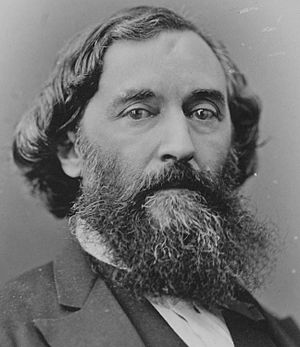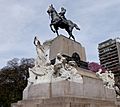Bartolomé Mitre facts for kids
Quick facts for kids
Bartolomé Mitre
|
|
|---|---|
 |
|
| President of Argentina | |
| In office 12 October 1862 – 12 October 1868 Interim: 12 December 1861 – 12 October 1862 |
|
| Vice President | Marcos Paz |
| Preceded by | Juan Esteban Pedernera |
| Succeeded by | Domingo Faustino Sarmiento |
| 7th Governor of Buenos Aires | |
| In office 3 May 1860 – 11 October 1862 |
|
| Vice Governor | Manuel Ocampo Vicente Cazón |
| Preceded by | Felipe Llavallol |
| Succeeded by | Vicente Cazón |
| Personal details | |
| Born | 26 June 1821 Buenos Aires |
| Died | 19 January 1906 (aged 84) Buenos Aires |
| Resting place | La Recoleta Cemetery |
| Nationality | Argentine |
| Political party | Colorado (Uruguay) Unitary (1851–1862) Liberal (1862–1874) National (1874) Civic Union (1890–1891) National Civic Union (1891–1906) |
| Spouse | Delfina Vedia |
| Military service | |
| Allegiance | |
| Branch/service | |
| Rank | |
Bartolomé Mitre Martínez (born June 26, 1821 – died January 19, 1906) was an important Argentine leader. He was a soldier, writer, and politician. He became the President of Argentina from 1862 to 1868. He was the first president of a truly united Argentina.
People remember him as a very talented person. He was a soldier, politician, journalist, historian, writer, and poet. He played a big part in Argentina's history in the late 1800s. He believed in liberal ideas for Argentina.
Contents
Early Life and Adventures
Bartolomé Mitre was born on June 26, 1821, in Buenos Aires, Argentina. His family name, Mitre, came from his ancestors who were from Greece. Their original name was Mitropoulos.
In 1831, when he was ten, his family moved to Uruguay. He joined the military and graduated in 1839. He became a second lieutenant in the artillery. He also worked as a journalist. His writings supported a leader named Fructuoso Rivera. In 1846, Rivera made him a lieutenant colonel in the Uruguayan Army.
Mitre joined the Colorado Party in Uruguay. They fought against another group called the Blancos. This led him to support the unitarios in Argentina. The unitarios were fighting against the government of Juan Manuel de Rosas in Buenos Aires. Rosas was an ally of the Uruguayan Blancos.
During this time, Mitre started writing poems and articles for newspapers in Uruguay.
Later, he moved to Bolivia, then to Chile. In Chile, he met another Argentine exile, Juan Bautista Alberdi. They both wrote for a newspaper in Valparaíso. After that, Mitre wrote for El Progreso in Santiago. This newspaper was led by Domingo Faustino Sarmiento, who would later become president of Argentina.
Return to Argentina
Mitre came back to Argentina after Juan Manuel de Rosas was defeated. This happened at the Battle of Caseros in 1852. Mitre became a leader in a revolt in Buenos Aires Province. This revolt was against Justo José de Urquiza's plan for a federal system.
After the Revolution of 11 September 1852, Buenos Aires Province separated from the rest of Argentina. Mitre was given important jobs in the provincial government.
President of Argentina
In 1859, there was a civil war. Mitre's forces were defeated by Urquiza at the Battle of Cepeda in 1860. After this, Buenos Aires agreed to rejoin the Argentine Confederation. They settled disagreements about sharing customs money.
However, Mitre won the Battle of Pavón in 1861. This victory helped him get important changes to the country's rules. One big change was how the president would be chosen. In October 1862, Mitre was elected president. This finally brought political unity to Argentina. A time of progress and reforms began.
During the Paraguayan War, Mitre was first put in charge of the allied forces.
Mitre also started La Nación, a very important newspaper in South America, in 1870. He ran for president again in 1874. He lost to Nicolás Avellaneda. Mitre tried to stop Avellaneda from becoming president. He even took control of a gunboat. But he was defeated. President Avellaneda decided to spare his life.
Later, in 1890, Mitre helped start the Civic Union party. This was after a big protest called the Revolution of the Park. The Civic Union later split. Mitre then founded the National Civic Union.
Later Life and Writings
In his later years, Mitre spent a lot of time writing. He wrote many historical books and articles. Some people have questioned his historical writings, saying he sometimes left out important details.
He also wrote poetry and fiction. He translated famous books, like Dante's The Divine Comedy, into Spanish. Mitre was the grandfather of a poet named Margarita Abella Caprile. Like many important people of his time, he was a freemason.
Death and What He Left Behind
Bartolomé Mitre passed away in 1906. Many people came to mourn him. His funeral procession went from his home to La Recoleta Cemetery.
Mitre was a great example of an Argentine statesman in the 1800s. He believed in the ideals of the May Revolution. He helped create the Freedom Party, which was the first Argentine party with a clear liberal plan. This plan aimed to bring together the different groups in Argentina.
As a writer, he created poems, plays, and countless newspaper articles. He helped build historical science with his biographies. He translated classic works and gave powerful speeches. Mitre was a leading figure in politics and culture until his death.
Mitre supported the idea of universal direct suffrage. This means every citizen could vote directly. This idea was finally put into law in 1912.
When Mitre became president in 1862, Argentina faced many challenges. The country had little money and big debts. The government needed to be organized. New buildings were needed for national authorities. The army needed to be set up and paid. Basic public services were created. His government focused on important goals like education, encouraging people to move to Argentina, foreign investments, building railways, and settling land. His work as president helped set up modern Argentina.
Gallery
See also
 In Spanish: Bartolomé Mitre para niños
In Spanish: Bartolomé Mitre para niños







